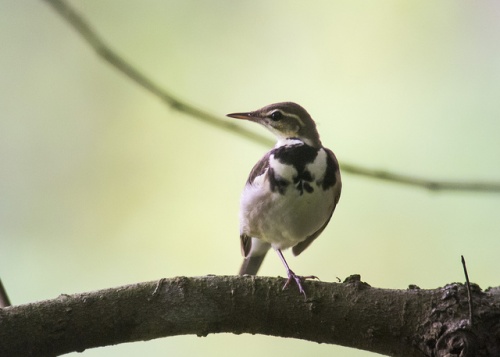(→External Links: New format for combined GSearch. Video search deleted as no longer available. GSearch checked template) |
|||
| (11 intermediate revisions by 4 users not shown) | |||
| Line 1: | Line 1: | ||
| − | {{ | + | [[Image:9737117494 a2d258b7ab z.jpg|thumb|500px|right|Photo by {{user|SeeToh|SeeToh}}<br />Former Bidadari Cemetery, [[Singapore]], September 2013]] |
| − | ;Dendronanthus indicus | + | ;[[:Category:Dendronanthus|Dendronanthus]] indicus |
| − | [[Image: | + | ==Identification== |
| − | + | [[Image:NTL 6143.jpg|thumb|350px|right|Photo by {{user|nhattanla|nhattanla}}<br />Hanoi, [[Vietnam]], February 2017]] | |
| − | Broad black | + | 16–18 cm (6¼-7 in)<br /> |
| + | Broad black crescent breast patch, separated from broken black crescent patch by creamy white breast band together with whitish wing bars diagnostic. Upperparts olive-brown with thin whitish [[Topography#Heads|supercilium]]. Underparts creamy white. | ||
==Distribution== | ==Distribution== | ||
| + | Breeding in far eastern [[Russia]], [[Korea]] and northern [[China]]; wintering south to [[India]]n subcontinent and southeast [[Asia]] to the [[Greater Sundas]], [[Indonesia]]. | ||
| + | |||
==Taxonomy== | ==Taxonomy== | ||
| + | This is a [[Dictionary_M-O#M|monotypic]] species<sup>[[#References|[1]]]</sup>. | ||
| + | |||
==Habitat== | ==Habitat== | ||
| + | Forests, forest edges, mangroves, plantation and scrubs. | ||
| + | |||
==Behaviour== | ==Behaviour== | ||
| + | Usually solitary or in pairs, foraging on the ground. Will perch on trees. Has been observed roosting communally in large numbers in scrubland. | ||
| + | ====Breeding==== | ||
| + | The nest is formed from rootlets, grass, leaves and twigs, held together by moss and webs, close to the trunk of a large tree. The 4 to 5 eggs are incubated by the female; the male helping to feed the brood. | ||
| + | ====Diet==== | ||
| + | Their diet consists of small insects, worms and snails etc. They are also known to fly catch from a perch. | ||
| + | ====Action==== | ||
| + | Frequently sways body side-ways in a cork screw like motion. | ||
| + | ====Vocalisation==== | ||
| + | '''Call''': a sharp metallic ping. | ||
| + | ==References== | ||
| + | #{{Ref-Clements6thAug16}}#ArKive | ||
| + | {{ref}} | ||
==External Links== | ==External Links== | ||
| − | + | {{GSearch|"Dendronanthus indicus" {{!}} "Forest Wagtail"}} | |
| − | [[Category:Birds]] | + | {{GS-checked}}1 |
| + | <br /> | ||
| + | <br /> | ||
| + | |||
| + | |||
| + | [[Category:Birds]] [[Category:Dendronanthus]] [[Category:Videos]] | ||
Latest revision as of 00:48, 17 January 2023
- Dendronanthus indicus
Identification
16–18 cm (6¼-7 in)
Broad black crescent breast patch, separated from broken black crescent patch by creamy white breast band together with whitish wing bars diagnostic. Upperparts olive-brown with thin whitish supercilium. Underparts creamy white.
Distribution
Breeding in far eastern Russia, Korea and northern China; wintering south to Indian subcontinent and southeast Asia to the Greater Sundas, Indonesia.
Taxonomy
This is a monotypic species[1].
Habitat
Forests, forest edges, mangroves, plantation and scrubs.
Behaviour
Usually solitary or in pairs, foraging on the ground. Will perch on trees. Has been observed roosting communally in large numbers in scrubland.
Breeding
The nest is formed from rootlets, grass, leaves and twigs, held together by moss and webs, close to the trunk of a large tree. The 4 to 5 eggs are incubated by the female; the male helping to feed the brood.
Diet
Their diet consists of small insects, worms and snails etc. They are also known to fly catch from a perch.
Action
Frequently sways body side-ways in a cork screw like motion.
Vocalisation
Call: a sharp metallic ping.
References
- Clements, J. F., T. S. Schulenberg, M. J. Iliff, D. Roberson, T. A. Fredericks, B. L. Sullivan, and C. L. Wood. 2016. The eBird/Clements checklist of birds of the world: v2016, with updates to August 2016. Downloaded from http://www.birds.cornell.edu/clementschecklist/download/
- ArKive
Recommended Citation
- BirdForum Opus contributors. (2024) Forest Wagtail. In: BirdForum, the forum for wild birds and birding. Retrieved 5 June 2024 from https://www.birdforum.net/opus/Forest_Wagtail
External Links
GSearch checked for 2020 platform.1





